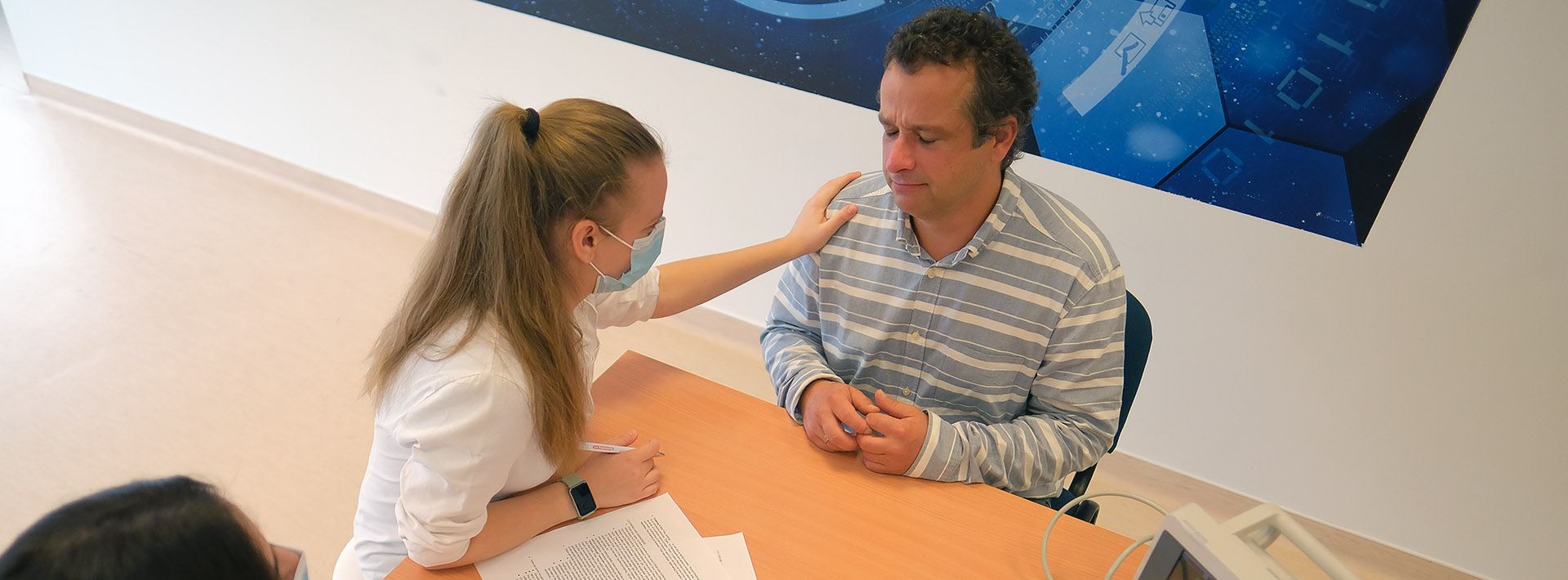Adatok
A Tantárgybejelentőben megadott hivatalos adatok az alábbi tanévre: 2023-2024
Tantárgyfelelős
-
Dr. Éva BELLYEI-POZSGAI
assistant professor,
Department of Primary Health Care
Óraszámok/félév
előadás: 0 óra
gyakorlat: 0 óra
szeminárium: 12 óra
összesen: 12 óra
Tárgyadatok
- Kód: OAF-GOO-T
- 1 kredit
- General Medicine
- Optional modul
- spring
OAP-BPR-T completed
Kurzus létszámkorlát
min. 5 fő – max. 25 fő
Campus kurzusként elérhető 25 fő számára. Campus-karok: ÁOK
Tematika
The course is a continuation of Medical Communication in Practice 1. The aim of the course is to encourage students to practise appropriate communication in emotionally challenging, difficult doctor-patient situations.
The first part focuses on managing emotional responses of patients and relatives. Students receive theoretical educational material prior to the classes, therefore, application of the communication models through experience-based approach can enable interactive participation of students with simulated patients in medical encounters.
1.Sensitizations of the students to emotional expressions of patients happen with the ‘4-ears model’.
2. Applying the NURSE-model students become equipped with communication techniques to deal with emotions adequately, thus, they can learn to support the emotional needs of patients.
3.Practice based on the application of the CALM-model facilitates learning de-escalation of anger.
The second part of the course focuses on breaking bad news and discussing difficult issues, with the aim of practising the elements of the SPIKES protocol through role-playing. Students are able to practice building trust with patients and relatives, breaking bad news honestly and openly, recognising and managing the patient's and their own emotional reactions to the delivery of bad news, and applying useful verbal and non-verbal elements of information delivery through case-based exercises.
The course was developed in collaboration with the Department of Behavioural Sciences, the Department of Languages for Biomedical Purposes and Communication and the Department of Primary Health Care.
Előadások
Gyakorlatok
Szemináriumok
- 1. Consultation Class 1. Dealing with Patient's emotions and breaking bad news. (Dr. Éva Pozsgay, Dr. Ágnes Csikós, Katalin Eklicsné Dr. Lepenye, István Hartung, Dr. Szilvia Heim, Dr. Ildikó Bán, Judit Szalai-Szolcsányi, Dr. Nóra Frank, Dr. Dániel Kürthy, Judit Szalai- Szolcsányi, Dr. Boróka Gács, Dr. Gergely Csaba)
- 2. Consultation Class 2. Dealing with emotional reactions and breaking bad news. (Katalin Eklicsné Dr. Lepenye, István Hartung, Dr. Szilvia Heim, Dr. Ildikó Bán, Judit Szalai-SzolcsányiDr. Ágnes Csikós, Dr. Éva Pozsgay, Dr. Nóra Frank, Dr. Dániel Kürthy, Judit Szalai- Szolcsányi, Dr. Boróka Gács, Dr. Gergely Csaba)
- 3. Dealing with patients’ and family members’ emotional reactions (angry, anxious, depressed…etc patients). Empathic communication. (Katalin Eklicsné Dr. Lepenye, István Hartung, Dr. Szilvia Heim, Dr. Ildikó Bán, Judit Szalai-Szolcsányi)
- 4. Dealing with patients’ and family members’ emotional reactions (angry, anxious, depressed…etc patients). Empathic communication. (Katalin Eklicsné Dr. Lepenye, István Hartung, Dr. Szilvia Heim, Dr. Ildikó Bán, Judit Szalai-Szolcsányi)
- 5. Dealing with patients’ and family members’ emotional reactions (angry, anxious, depressed…etc patients). Empathic communication. (Katalin Eklicsné Dr. Lepenye, István Hartung, Dr. Szilvia Heim, Dr. Ildikó Bán, Judit Szalai-Szolcsányi)
- 6. Dealing with patients’ and family members’ emotional reactions (angry, anxious, depressed…etc patients). Empathic communication. (Katalin Eklicsné Dr. Lepenye, István Hartung, Dr. Szilvia Heim, Dr. Ildikó Bán, Judit Szalai-Szolcsányi)
- 7. Dealing with patients’ and family members’ emotional reactions (angry, anxious, depressed…etc patients). Empathic communication. (Katalin Eklicsné Dr. Lepenye, István Hartung, Dr. Szilvia Heim, Dr. Ildikó Bán, Judit Szalai-Szolcsányi)
- 8. Communicating bad news. Communication with family members. (Dr. Ágnes Csikós, Dr. Éva Pozsgay, Dr. Nóra Frank, Dr. Dániel Kürthy, Judit Szalai- Szolcsányi, Dr. Boróka Gács, Dr. Gergely Csaba)
- 9. Communicating bad news. Communication with family members. (Dr. Ágnes Csikós, Dr. Éva Pozsgay, Dr. Nóra Frank, Dr. Dániel Kürthy, Judit Szalai- Szolcsányi, Dr. Boróka Gács, Dr. Gergely Csaba)
- 10. Communicating bad news. Communication with family members. (Dr. Ágnes Csikós, Dr. Éva Pozsgay, Dr. Nóra Frank, Dr. Dániel Kürthy, Judit Szalai- Szolcsányi, Dr. Boróka Gács, Dr. Gergely Csaba)
- 11. Communicating bad news. Communication with family members. (Dr. Ágnes Csikós, Dr. Éva Pozsgay, Dr. Nóra Frank, Dr. Dániel Kürthy, Judit Szalai- Szolcsányi, Dr. Boróka Gács, Dr. Gergely Csaba)
- 12. Communicating bad news. Communication with family members. (Dr. Ágnes Csikós, Dr. Éva Pozsgay, Dr. Nóra Frank, Dr. Dániel Kürthy, Judit Szalai- Szolcsányi, Dr. Boróka Gács, Dr. Gergely Csaba)
A tananyag elsajátításához szükséges segédanyagok
Kötelező irodalom
nincs
Saját oktatási anyag
Dealing with Patient’s emotions and Breaking bad news - Notes for medical students
Jegyzet
-
Ajánlott irodalom
A félév elfogadásának feltételei
Maximum of 25 % absence allowed
Félévközi ellenőrzések
Written test
Távolmaradás pótlásának lehetőségei
-
Vizsgakérdések
-
Vizsgáztatók
Gyakorlatok, szemináriumok oktatói
- Dr. Bán Ildikó
- Dr. Bellyeiné Dr. Pozsgai Éva
- Dr. Csaba Gergely József
- Dr. Csikós Ágnes Erika
- Dr. Frank Nóra
- Dr. Gács Boróka
- Dr. Heim Szilvia Mária
- Dr. Kürthy Dániel
- Eklicsné Dr. Lepenye Katalin
- Hartung István
- Szalai-Szolcsányi Judit
